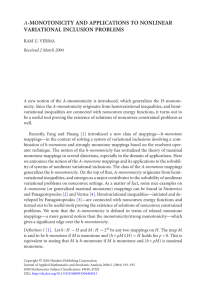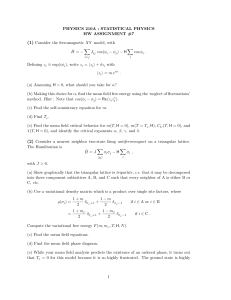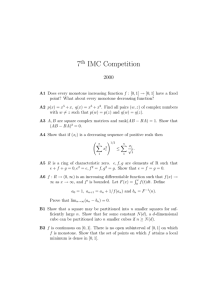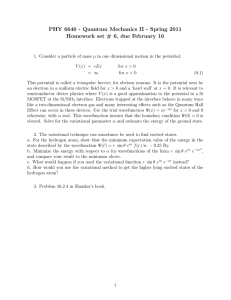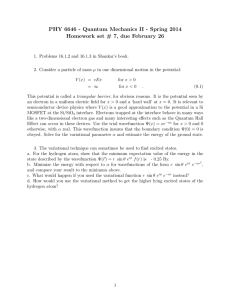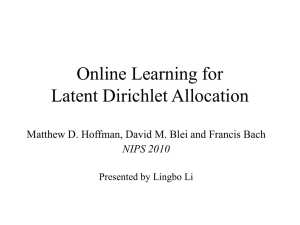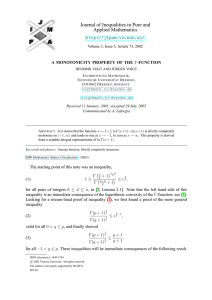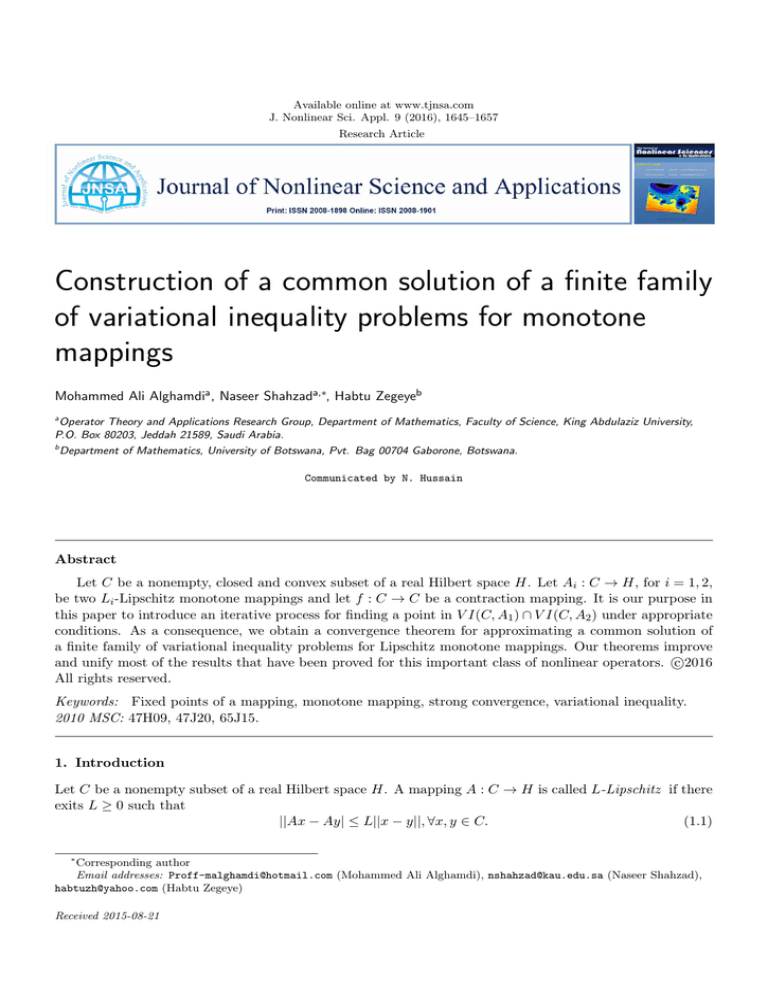
Available online at www.tjnsa.com
J. Nonlinear Sci. Appl. 9 (2016), 1645–1657
Research Article
Construction of a common solution of a finite family
of variational inequality problems for monotone
mappings
Mohammed Ali Alghamdia , Naseer Shahzada,∗, Habtu Zegeyeb
a
Operator Theory and Applications Research Group, Department of Mathematics, Faculty of Science, King Abdulaziz University,
P.O. Box 80203, Jeddah 21589, Saudi Arabia.
b
Department of Mathematics, University of Botswana, Pvt. Bag 00704 Gaborone, Botswana.
Communicated by N. Hussain
Abstract
Let C be a nonempty, closed and convex subset of a real Hilbert space H. Let Ai : C → H, for i = 1, 2,
be two Li -Lipschitz monotone mappings and let f : C → C be a contraction mapping. It is our purpose in
this paper to introduce an iterative process for finding a point in V I(C, A1 ) ∩ V I(C, A2 ) under appropriate
conditions. As a consequence, we obtain a convergence theorem for approximating a common solution of
a finite family of variational inequality problems for Lipschitz monotone mappings. Our theorems improve
c
and unify most of the results that have been proved for this important class of nonlinear operators. 2016
All rights reserved.
Keywords: Fixed points of a mapping, monotone mapping, strong convergence, variational inequality.
2010 MSC: 47H09, 47J20, 65J15.
1. Introduction
Let C be a nonempty subset of a real Hilbert space H. A mapping A : C → H is called L-Lipschitz if there
exits L ≥ 0 such that
||Ax − Ay| ≤ L||x − y||, ∀x, y ∈ C.
(1.1)
∗
Corresponding author
Email addresses: Proff-malghamdi@hotmail.com (Mohammed Ali Alghamdi), nshahzad@kau.edu.sa (Naseer Shahzad),
habtuzh@yahoo.com (Habtu Zegeye)
Received 2015-08-21
M. A. Alghamdi, N. Shahzad, H. Zegeye, J. Nonlinear Sci. Appl. 9 (2016), 1645–1657
1646
If L = 1, then T is called nonexpansive and if L < 1, then T is called a contraction. It follows that every
contraction mapping is nonexpansive and every nonexpansive mapping is Lipschitz.
A mapping A : C → H is called η-strongly monotone if there exists a positive real number η such that
hAx − Ay, x − yi ≥ η||x − y||2 , for all x, y ∈ C.
(1.2)
A is called α-inverse strongly monotone if there exists a positive real number α such that
hAx − Ay, x − yi ≥ α||Ax − Ay||2 , for all x, y ∈ C.
(1.3)
We note that any α-inverse strongly monotone A is Lipschitz, that is ||Ax − Ay|| ≤ L||x − y||, ∀x, y ∈ C,
where L = α1 .
A is called monotone if
hAx − Ay, x − yi ≥ 0, for all x, y ∈ C.
(1.4)
Clearly, the class of monotone mappings includes the class of α-inverse strongly monotone and the class of
η-strongly monotone mappings.
Let C be a nonempty, closed and convex subset of H and let A : C → H be a nonlinear mapping. The
variational inequality problem for A and C is the problem of finding a point x∗ ∈ C satisfying
hAx∗ , x − x∗ i ≥ 0, ∀x ∈ C.
(1.5)
We denote the solution set of this problem by V I(C, A). We know that the solution set of V I(C, A) is
always closed and convex under the assumption that A is continuous and monotone.
The theory of variational inequality has emerged as a very natural generalization of the theory of boundary
value problems and allows us to consider new problems arising from many fields of applied mathematics,
such as mechanics, physics, engineering, the theory of convex programming, and the theory of control: See,
for instance, [9, 11, 17, 18, 19, 23, 24]. Variational inequalities were introduced and studied by Stampacchia
[13] in 1964. Since then variational inequality problems has been extensively studied in the literature, see
[7, 11, 14, 20, 25, 26, 28, 30, 31, 32] and the reference therein. There are several iterative methods for solving
variational inequality problems. See, e.g., [2, 3, 4, 7, 11, 23, 24, 27]. The basic idea consists of extending the
projected gradient method for constrained optimization, i.e., for the problem of minimizing f (x) subject to
x ∈ C. For x0 ∈ C, compute the sequence {xn } in the following manner:
xn+1 = PC [xn − αn ∇f (xn )], n ≥ 0,
(1.6)
where {αn } is a positive real sequence satisfying certain conditions and PC is the metric projection onto C.
See [1] for convergence properties of this method for the case in which f : R2 → R is convex and differentiable
function. An immediate extension of the method (1.6) to V I(C, A) is the iterative procedure given by
xn+1 = PC [xn − αn Axn ], n ≥ 0.
(1.7)
Convergence results for this method require some monotonicity properties of A. Note that for the method
given by (1.7) there is no chance of relaxing the assumption on A to plain monotonicity. The typical example
consists of taking C = R2 and A, a rotation with a π2 angle. A is monotone and the unique solution of
V I(C, A) is x∗ = 0. However, it is easy to check that ||xn+1 || > ||xn || for all n ≥ 0 and all αn > 0, therefore
the sequence generated by (1.7) moves away from the solution, independently of the choice of the sequence
αn . To overcome this weakness of the method defined by (1.7), Korpelevich [8] proposed a modification
of the method, called the extragradient algorithm in the finite-dimensional Euclidean space Rn under the
assumption that a set C ⊂ Rn is closed and convex and a mapping A of C into Rn is monotone and
L-Lipschitz continuous,
yn = PC [xn − λAxn ],
(1.8)
xn+1 = PC [xn − λAyn ], n ≥ 0,
M. A. Alghamdi, N. Shahzad, H. Zegeye, J. Nonlinear Sci. Appl. 9 (2016), 1645–1657
1647
for all n ≥ 0, where λ ∈ (0, L1 ). He proved that if V I(C, A) is nonempty, then the sequences {xn } and
{yn }, generated by (1.8), converge to the same point x∗ ∈ V I(C, A). The difference in (1.8) is that A
is evaluated twice and the projection is computed twice at each iteration, but the benefit is significant,
because the resulting algorithm is applicable to the whole class of variational inequalities for monotone
mappings. Korpelevich’s method has received great attention by many authors, who improved it in various
ways; see, e.g., [4, 6, 7, 9, 10, 15, 23, 30] and the references therein. In 2006, Nadezhkina and Takahashi [10]
suggested the following modified Korpelevich’s method for a solution of a variational inequality V I(C, A) for
L-Lipschitz continuous monotone mapping A in infinite-dimensional Hilbert spaces. Let {xn } be a sequence
generated from an arbitrary x0 ∈ C by
yn = PC [xn − λn Axn ],
(1.9)
xn+1 = αn xn + (1 − αn )PC [xn − λn Ayn ], n ≥ 0,
where PC is a metric projection from H onto C, {λn } ⊂ [a, b] for some a, b ∈ (0, 1/L) and {αn } ⊂ [c, d]
for some c, d ∈ (0, 1). Then, they proved that the sequences {xn }, {yn } converge weakly to the minimumnorm point of V I(C, A). We remark that Korpelevich’s modified method (1.9) has only weak convergence
in the infinite-dimensional Hilbert spaces (see Censor et al. [5] and [4]). So to obtain strong convergence
the original method was modified by several authors. For example in [2, 6, 21] it is proved that some
very interesting Korpelevich-type algorithms strongly converge to a solution of V I(C, A). Recently, Yao
et al. [21] suggested the following modified Korpelevich’s method for a solution of a variational inequality
V I(C, A) for α-inverse strongly monotone mapping A in infinite-dimensional Hilbert spaces. Let {xn } be a
sequence generated from an arbitrary x0 ∈ C by
yn = PC [xn − λAxn − αn xn ],
(1.10)
xn+1 = PC [xn − λAyn + µ(yn − xn )], n ≥ 0,
where PC is a metric projection from H onto C, λ ∈ [a, b] ⊂ (0, 2α), µ ∈ (0, 1) and {αn } ⊂ (0, 1) satisfying
certain conditions. Then, they proved that the sequence {xn } converges strongly to the minimum-norm
point of V I(C, A). One may also see related results in [21]. More recently, Yao et al. [22] investigated the
problem of finding a solution of variational inequality V I(C, A) for α-inverse strongly monotone mapping
A by considering the following iterative algorithm:
yn = PC [xn − λn Axn + αn (f xn − xn )],
(1.11)
xn+1 = PC [xn − µn Ayn + γn (yn − xn )], n ≥ 0,
where f : C → H is a ρ-contractive mapping and {αn }, {λn }, {µn } and {γn } are real sequences satisfying
certain conditions. Then they proved that the sequence {xn } generated by (1.11) converges strongly to
x∗ ∈ V I(C, A).
A natural question arises: can we obtain an iterative scheme which converges strongly to a solution V I(C, A)
of a variational inequality problem for a more general class of monotone mappings?
It is our purpose in this paper to propose an extragradient-type method for solving a common solution
of two variational inequality problems for Lipschitz monotone mappings. As a consequence, we obtain
a convergence theorem for approximating a common solution of a finite family of variational inequality
problems for Lipschitz monotone mappings. The results obtained in this paper improve and extend the
results of Nadezhkina and Takahashi [10], Yao et al. [21] and Yao et al. [22] and some other results in this
direction.
2. Preliminaries
Let C be a nonempty, closed and convex subset of a real Hilbert space H. We remark that for every point
x ∈ H, there exists a unique nearest point in C, denoted by PC x, satisfying
||x − PC x|| ≤ ||x − y|| for all y ∈ C.
(2.1)
M. A. Alghamdi, N. Shahzad, H. Zegeye, J. Nonlinear Sci. Appl. 9 (2016), 1645–1657
1648
The mapping PC is called the metric projection of H onto C. We know that PC is a nonexpansive mapping
of H onto C and is characterized by the following properties (see, e.g., [16]):
PC x ∈ C and hx − PC x, PC x − yi ≥ 0, for all x ∈ H, y ∈ C and
(2.2)
||y − PC x||2 ≤ ||x − y||2 − ||x − PC x||2 , for all x ∈ H, y ∈ C.
(2.3)
Let A : C → H be a monotone mapping. We note that in the context of variational inequality problem we
have that
x∗ ∈ V I(C, A) if and only if x∗ = PC (x∗ − λAx∗ ), ∀λ > 0.
(2.4)
A monotone mapping B : C → 2H is called maximal monotone if its graph G(B) is not properly contained
in the graph of any other monotone mapping. That is, a monotone mapping B is maximal if and only if,
for (x, u) ∈ H × H, hx − y, u − vi ≥ 0, for every (y, v) ∈ G(B) implies u ∈ Bx. Let A be a monotone and
L-Lipschitz mapping of C into H and let NC v be the normal cone to C at v ∈ C; i.e.,
NC v = {w ∈ H : hv − u, wi ≥ 0, ∀u ∈ C}.
Define
Bv =
Av + NC v, if v ∈ C,
∅,
if v ∈
/ C.
(2.5)
Then, B is maximal monotone and 0 ∈ Bv if and only if v ∈ V I(C, A) (see, e.g., [12]).
In the sequel we shall make use of the following lammas.
Lemma 2.1 ([29]). Let H be a real Hilbert space. Then for all xi ∈ H and αi ∈ [0, 1], for i = 1, 2, 3 such
that α1 + α2 + α3 = 1 the following equality holds:
2
||α1 x1 + α2 x2 + α3 x3 || =
3
X
i=1
αi ||xi ||2 −
X
αi αj ||xi − xj ||2 .
1≤i,j≤3
Lemma 2.2. Let H be a real Hilbert space. Then for any given x, y ∈ H, the following inequality holds:
||x + y||2 ≤ ||x||2 + 2hy, x + yi.
Lemma 2.3 ([18]). Let {an } be a sequence of nonnegative real numbers satisfying the following relation:
an+1 ≤ (1 − αn )an + αn δn , n ≥ n0 ,
where {αn } ⊂ (0, 1) and {δn } ⊂ R satisfying the following conditions:
lim sup δn ≤ 0. Then, lim an = 0.
n→∞
lim αn = 0,
n→∞
∞
X
αn = ∞, and
n=1
n→∞
Lemma 2.4 ([9]). Let {an } be sequences of real numbers such that there exists a subsequence {ni } of {n}
such that ani < ani +1 , for all i ∈ N. Then there exists a nondecreasing sequence {mk } ⊂ N such that
mk → ∞ and the following properties are satisfied by all (sufficiently large) numbers k ∈ N:
amk ≤ amk +1 and ak ≤ amk +1 .
In fact, mk = max{j ≤ k : aj < aj+1 }.
M. A. Alghamdi, N. Shahzad, H. Zegeye, J. Nonlinear Sci. Appl. 9 (2016), 1645–1657
1649
3. Main Result
Theorem 3.1. Let C be a nonempty, closed and convex subset of a real Hilbert space H. Let Ai : C → H be
a finite family of Li -Lipschitz monotone mappings with Lipschitz constants Li , for i = 1, 2. Let f : C → C
be a contraction mapping. Assume that F = ∩2i=1 V I(C, Ai ) is nonempty. Let {xn } be a sequence generated
from an arbitrary x0 ∈ C by
zn = PC [xn − γn A2 xn ],
yn = PC [xn − γn A1 xn ],
(3.1)
xn+1 = αn f (xn ) + (1 − αn ) an xn + bn PC [xn − γn A1 yn ] + cn PC [xn − γn A2 zn ] ,
where PC is a metric projection from H onto C, γn ⊂ [a, b] ⊂ (0, L1 ), for L := max{L1 , L2 }, {an }, {bn },
{cn } ⊂ [e, 1) ⊂ (0, 1), such that an + bn + cn = 1 and {αn } ⊂ (0, c] ⊂ (0, 1) for all n ≥ 0 satisfies lim αn = 0
n→∞
P
and
αn = ∞. Then, {xn } converges strongly to a point x∗ ∈ F which is the unique solution of the
variational inequality h(I − f )(x∗ ), x − x∗ i ≥ 0 for all x ∈ F.
Proof. Let p ∈ F, un = PC (xn − γn A1 yn ) and vn = PC (xn − γn A2 zn ) for all n ≥ 0. Then, from (2.3) we
have
||un − p||2 ≤ ||xn − γn A1 yn − p||2 − ||xn − γn A1 yn − un ||2
= ||xn − p||2 − ||xn − un ||2 + 2γn hA1 yn , p − un i
= ||xn − p||2 − ||xn − un ||2 + 2γn hA1 yn − A1 p, p − yn i
+ hA1 p, p − yn i + hA1 yn , yn − un i
≤ ||xn − p||2 − ||xn − un ||2 + 2γn hA1 yn , yn − un i
= ||xn − p||2 − ||xn − yn ||2 − 2hxn − yn , yn − un i
− ||yn − un ||2 + 2γn hA1 yn , yn − un i
= ||xn − p||2 − ||xn − yn ||2 − ||yn − un ||2
+ 2hxn − γn A1 yn − yn , un − yn i
(3.2)
and from (2.2), we obtain
hxn − γn A1 yn − yn , un − yn i = hxn − γn A1 xn − yn , un − yn i
+ hγn A1 xn − γn A1 yn , un − yn i
≤ hγn A1 xn − γn A1 yn , un − yn i
≤ γn L||xn − yn ||||un − yn ||.
(3.3)
Thus, from (3.2) and (3.3) we get
||un − p||2 ≤ ||xn − p||2 − ||xn − yn ||2 − ||yn − un ||2
+ 2γn L||xn − yn ||||un − yn ||
≤ ||xn − p||2 − ||xn − yn ||2 − ||yn − un ||2
+ γn L(||xn − yn ||2 + ||yn − un ||2 )
≤ ||xn − p||2 + (γn L − 1)||xn − yn ||2 + (γn L − 1)||yn − un ||2 .
(3.4)
||vn − p||2 ≤ ||xn − p||2 + (γn L − 1)||xn − zn ||2 + (γn L − 1)||zn − vn ||2 .
(3.5)
Likewise, we obtain that
Thus, from (3.1), Lemma 2.1, (3.4) and (3.5) we have the following:
||xn+1 − p||2 =||αn f (xn ) + (1 − αn )(an xn + bn un + cn vn ) − p||2
M. A. Alghamdi, N. Shahzad, H. Zegeye, J. Nonlinear Sci. Appl. 9 (2016), 1645–1657
1650
≤αn ||f (xn ) − p||2 + (1 − αn )||an (xn − p) + bn (un − p)
+ cn (vn − p)||2
≤αn ||f (xn ) − p||2 + (1 − αn ) an ||xn − p||2 + bn ||un − p||2
+ cn ||vn − p||2
≤αn ||f (xn ) − p||2 + (1 − αn )an ||xn − p||2 + (1 − αn )bn ||xn − p||2
+ (γn L − 1)||xn − yn ||2 + (γn L − 1)||yn − un ||2
+ (1 − αn )cn ||xn − p||2 + (γn L − 1)||xn − zn ||2
+ (γn L − 1)||zn − vn ||2
=αn ||f (xn ) − p||2 + (1 − αn )||xn − p||2 + (1 − αn )bn
× (γn L − 1)||xn − yn ||2 + (1 − αn )bn (γn L − 1)
× ||yn − un ||2 + (1 − αn )cn (γn L − 1)||xn − zn ||2
+ (1 − αn )cn (γn L − 1)||zn − vn ||2 .
Now, since from the hypotheses, we have γn <
1
L
(3.6)
for all n ≥ 1, the inequality (3.6) implies that
||xn+1 − p||2 ≤ αn ||f (xn ) − p||2 + (1 − αn )||xn − p||2 .
(3.7)
Furthermore, we have that
2
||f (xn ) − p||2 = ||f (xn ) − f (p)|| + ||f (p) − p||
2
≤ ρ||xn − p|| + ||f (p) − p||
≤ ρ2 ||xn − p||2 + ||f (p) − p||2 + 2ρ||xn − p||||f (p) − p||
≤ ρ(1 + ρ)||xn − p||2 + (1 + ρ)||f (p) − p||2 ,
(3.8)
where ρ is a contraction constant of f . Substituting (3.8) into (3.7) we get that
||xn+1 − p||2 ≤ (1 − αn (1 − ρ(1 + ρ)))||xn − p||2 + αn (1 + ρ)||f (p) − p||2 .
Therefore, by induction we get that
||xn+1 − p||2 ≤ max{||x0 − p||2 ,
1+ρ
||f (p) − p||2 }, ∀n ≥ 0,
1 − ρ(1 + ρ)
which implies that {xn }, {yn }, {zn }, {un } and {vn } are bounded.
Let x∗ = PF f (x∗ ). Then, using (3.1), Lemma 2.2, Lemma 2.1, and following the methods used to get (3.6)
we obtain
||xn+1 − x∗ ||2 =||αn (f (xn ) − x∗ ) + (1 − αn ) (an xn + bn un + cn vn ) − x∗ ||2
≤(1 − αn )||an xn + bn un + cn vn − x∗ ||2
+ 2αn hf (xn ) − x∗ , xn+1 − x∗ i
≤(1 − αn )an ||xn − x∗ ||2 + (1 − αn )bn ||un − x∗ ||2
+ (1 − αn )cn ||vn − x∗ ||2 − (1 − αn )bn an ||un − xn ||2
− (1 − αn )cn an ||vn − xn ||2 + 2αn hf (xn ) − x∗ , xn+1 − x∗ i
≤(1 − αn )an ||xn − x∗ ||2 + (1 − αn )bn ||xn − x∗ ||2
+ (γn L − 1)||xn − yn ||2 + (γn L − 1)||yn − un ||2
+ (1 − αn )cn ||xn − x∗ ||2 + (γn L − 1)||xn − zn ||2
M. A. Alghamdi, N. Shahzad, H. Zegeye, J. Nonlinear Sci. Appl. 9 (2016), 1645–1657
1651
+ (γn L − 1)||zn − vn ||2 − (1 − αn )bn an ||un − xn ||2
− (1 − αn )cn an ||vn − xn ||2 + 2αn hf (xn ) − x∗ , xn+1 − x∗ i
=(1 − αn )||xn − x∗ ||2 + (1 − αn )bn (γn L − 1)||xn − yn ||2
+ (1 − αn )bn (γn L − 1)||yn − un ||2 + (1 − αn )cn (γn L − 1)
× ||xn − zn ||2 + (1 − αn )cn (γn L − 1)||zn − vn ||2
− (1 − αn )bn an ||un − xn ||2 − (1 − αn )cn an ||vn − xn ||2
+ 2αn hf (xn ) − x∗ , xn+1 − x∗ i
∗ 2
(3.9)
∗
∗
≤(1 − αn )||xn − x || + 2αn hf (xn ) − x , xn+1 − x i.
(3.10)
But
hf (xn ) − x∗ , xn+1 − x∗ i =hf (xn ) − x∗ , xn − x∗ i + hf (xn ) − x∗ , xn+1 − xn i
≤hf (xn ) − f (x∗ ), xn − x∗ i + hf (x∗ ) − x∗ , xn − x∗ i
+ ||xn+1 − xn ||||f (xn ) − x∗ ||
≤ρ||xn − x∗ ||2 + hf (x∗ ) − x∗ , xn − x∗ i
+ ||xn+1 − xn ||||f (xn ) − x∗ ||.
(3.11)
Thus, substituting (3.11) in (3.10) we obtain that
||xn+1 − x∗ ||2 ≤(1 − αn (1 − 2ρ))||xn − x∗ ||2 + 2αn hf (x∗ ) − x∗ , xn − x∗ i
+ 2αn ||xn+1 − xn ||.||f (xn ) − x∗ ||.
(3.12)
Now, we consider two cases.
Case 1. Suppose that there exists n0 ∈ N such that {||xn − x∗ ||} is decreasing for all n ≥ n0 . Then, we get
that, {||xn − x∗ ||)} is convergent. Thus, from (3.9), the fact that γn < b < L1 for all n ≥ 0 and αn → 0 as
n → ∞, we have that
un − xn → 0, vn − xn → 0, yn − xn → 0, zn − xn → 0, zn − vn → 0, yn − un → 0 as n → ∞.
(3.13)
Moreover, from (3.1) and (3.13) we get that
xn+1 − xn =αn (f (xn ) − xn ) + (1 − αn ) bn (un − xn ) + cn (vn − xn ) → 0 as n → ∞.
(3.14)
Furthermore, since {xn } is bounded subset of H which is reflexive, we can choose a subsequence {xnj } of
{xn } such that xnj * z and lim suphf (x∗ ) − x∗ , xn − x∗ i = lim hf (x∗ ) − x∗ , xnj − x∗ i. This implies from
j→∞
n→∞
(3.13) that unj * z and vnj * z.
Now, we show that z ∈ ∩2i=1 V I(C, A). But, since Ai , for each i ∈ {1, 2}, is Lipschitz continuous, we have
||A1 ynj − A1 unj || → 0 as j → ∞.
Let
B1 x =
A1 x + NC x, if x ∈ C,
∅,
if x ∈
/ C,
(3.15)
where NC (x) is the normal cone to C at x ∈ C given by NC (x) = {w ∈ H : hx − u, wi ≥ 0 for all u ∈ C}.
Then, B1 is maximal monotone and 0 ∈ B1 x if and only if x ∈ V I(C, A1 ) (see, e.g. [12]). Let (v, w) ∈ G(B1 ).
Then, we have w ∈ B1 v = A1 v+NC v and hence w−A1 v ∈ NC v. Thus, we get hv−u, w−A1 vi ≥ 0, for all u ∈
C. On the other hand, since unj = PC (xnj −γnj A1 ynj ) and v ∈ C, we have hxnj −γnj A1 ynj −unj , unj −vi ≥ 0,
and hence, hv − unj , (unj − xnj )/γnj + A1 ynj i ≥ 0. Therefore, from w − A1 v ∈ NC v and unj ∈ C we get
M. A. Alghamdi, N. Shahzad, H. Zegeye, J. Nonlinear Sci. Appl. 9 (2016), 1645–1657
1652
hv − unj , wi ≥hv − unj , A1 vi
≥hv − unj , A1 vi − hv − unj , (unj − xnj )/γnj + A1 ynj i
=hv − unj , A1 v − A1 unj i + hv − unj , A1 unj − A1 ynj i
− hv − unj , (unj − xnj )/γnj i
≥hv − unj , A1 unj − A1 ynj i − hv − unj , (unj − xnj )/γnj i.
This implies that hv − z, wi ≥ 0, as j → ∞. Then, maximality of B1 gives that z ∈ B1−1 (0). Therefore,
z ∈ V I(C, A1 ). Similarly, with the use of vnj = PC (xnj − γnj A2 znj ) we get that z ∈ V I(C, A2 ) and hence
z ∈ ∩2i=1 V I(C, Ai ). Thus, from 2.2, we immediately obtain that
lim suphf (x∗ ) − x∗ , xn − x∗ i = lim hf (x∗ ) − x∗ , xnj − x∗ i
j→∞
∗
n→∞
=hf (x ) − x∗ , z − x∗ i ≤ 0.
(3.16)
Hence, it follows from (3.12), (3.14), (3.16) and Lemma 2.3 that ||xn − x∗ || → 0 as n → ∞. Consequently,
xn → x∗ = PF f (x∗ ).
Case 2. Suppose that there exists a subsequence {ni } of {n} such that
||xni − x∗ || < ||xni +1 − x∗ ||
for all i ∈ N. Then, by Lemma 2.4, there exist a nondecreasing sequence {mk } ⊂ N such that mk → ∞, and
||xmk − x∗ || ≤ ||xmk +1 − x∗ || and ||xk − x∗ || ≤ ||xmk +1 − x∗ ||
(3.17)
for all k ∈ N. Now, from (3.9), the fact that γn < L1 for all n ≥ 0 and αn → 0 as n → ∞, we get that
umk − xmk → 0, vmk − xmk → 0, ymk − xmk → 0, zmk − xmk → 0, zmk − vmk → 0, ymk − umk → 0 as k → ∞.
Thus, following the method in Case 1, we obtain
lim suphf (x∗ ) − x∗ , xmk − x∗ i ≤ 0.
(3.18)
k→∞
Now, from (3.12) we have that
||xmk +1 − x∗ ||2 ≤(1 − αmk (1 − 2ρ))||xmk − x∗ ||2 + 2αmk hf (x∗ ) − x∗ , xmk − x∗ i
+ 2αmk ||xmk +1 − xmk ||.||f (xmk ) − x∗ ||.
(3.19)
and hence (3.17) and (3.19) imply that
αmk (1 − 2ρ)||xmk − x∗ ||2 ≤||xmk − x∗ ||2 − ||xmk +1 − x∗ ||2 + 2αmk hf (x∗ ) − x∗ , xmk − x∗ i
+ 2αmk ||xmk +1 − xmk ||.||f (xmk ) − x∗ ||.
But the fact that αmk > 0 implies that
(1 − 2ρ)||xmk − x∗ ||2 ≤ 2hf (x∗ ) − x∗ , xmk − x∗ i + 2||xmk +1 − xmk ||.||f (xmk ) − x∗ ||.
Thus, using (3.18) and (3.14) we get that ||xmk − x∗ || → 0 as k → ∞. This together with (3.19) implies that
||xmk +1 − x∗ || → 0 as k → ∞. But ||xk − x∗ || ≤ ||xmk +1 − x∗ || for all k ∈ N gives that xk → x∗ . Therefore,
from the above two cases, we can conclude that {xn } converges strongly to a point x∗ = PF f (x∗ ), which
satisfies the variational inequality h(I − f )(x∗ ), x − x∗ i ≥ 0, for all x ∈ F. The proof is complete.
If, in Theorem 3.1, we assume that f (x) = u ∈ C, a constant mapping, then we get the following corollary.
M. A. Alghamdi, N. Shahzad, H. Zegeye, J. Nonlinear Sci. Appl. 9 (2016), 1645–1657
1653
Corollary 3.2. Let C be a nonempty, closed and convex subset of a real Hilbert space H. Let Ai : C → H
be a finite family of Li -Lipschitz monotone mappings with Lipschitz constants Li , for i = 1, 2. Assume that
F = ∩2i=1 V I(C, Ai ) is nonempty. Let {xn } be a sequence generated from an arbitrary x0 , u ∈ C by
zn = PC [xn − γn A2 xn ],
yn = PC [xn − γn A1 xn ],
(3.20)
xn+1 = αn u + (1 − αn ) an xn + bn PC [xn − γn A1 yn ] + cn PC [xn − γn A2 zn ] ,
where PC is a metric projection from H onto C, γn ⊂ [a, b] ⊂ (0, L1 ), for L := max{L1 , L2 }, {an }, {bn },
{cn } ⊂ [e, 1) ⊂ (0, 1), such that an + bn + cn = 1 and {αn } ⊂ (0, c] ⊂ (0, 1) for all n ≥ 0 satisfies lim αn = 0
n→∞
P
and
αn = ∞. Then, {xn } converges strongly to a point x∗ ∈ F which is the unique solution of the
variational inequality hx∗ − u, x − x∗ i ≥ 0 for all x ∈ F.
Remark 3.3. We note that when f (x) = u ∈ C we observe that the sequence {xn } converges strongly to the
point x∗ ∈ F which is nearest to u.
If, in Theorem 3.1 we assume only one variational inequality problem for a monotone mapping A, then we
obtain the following corollary.
Corollary 3.4. Let C be a nonempty, closed and convex subset of a real Hilbert space H. Let A : C → H
be an L-Lipschitz monotone mapping with Lipschitz constant L. Let f : C → C be a contraction mapping.
Assume that F = V I(C, A) is nonempty. Let {xn } be a sequence generated from an arbitrary x0 ∈ C by
yn = PC [xn − γn Axn ],
(3.21)
xn+1 = αn f (xn ) + (1 − αn ) an xn + (1 − an )PC [xn − γn Ayn ] ,
where PC is a metric projection from H onto C, γn P
⊂ [a, b] ⊂ (0, L1 ), {an } ⊂ [e, 1) ⊂ (0, 1) and {αn } ⊂
(0, c] ⊂ (0, 1) for all n ≥ 0 satisfies lim αn = 0 and
αn = ∞. Then, {xn } converges strongly to a point
n→∞
x∗ ∈ F, which is the unique solution of the variational inequality h(I − f )(x∗ ), x − x∗ i ≥ 0 for all x ∈ F.
If, in Theorem 3.1, we assume that Ai , for i = 1, 2, are αi -inverse strongly monotone mappings, then both
are L-Lipschitz with constant L = max{ α11 , α12 } and hence we get the following corollary.
Corollary 3.5. Let C be a nonempty, closed and convex subset of a real Hilbert space H. Let Ai : C → H
be a finite family of αi -inverse strongly monotone mappings. Let f : C → C be a contraction mapping.
Assume that F = ∩2i=1 V I(C, Ai ) is nonempty. Let {xn } be a sequence generated from an arbitrary x0 ∈ C
by
zn = PC [xn − γn A2 xn ],
yn = PC [xn − γn A1 xn ],
(3.22)
xn+1 = αn f (xn ) + (1 − αn ) an xn + bn PC [xn − γn A1 yn ] + cn PC [xn − γn A2 zn ] ,
where PC is a metric projection from H onto C, γn ⊂ [a, b] ⊂ (0, L1 ), for L = max{ α11 , α12 }, {an }, {bn }, {cn } ⊂
[e, 1) ⊂ (0, 1), such that an + bn + cn = 1 and {αn } ⊂ (0, c] ⊂ (0, 1) for all n ≥ 0 satisfies lim αn = 0 and
n→∞
P
αn = ∞. Then, {xn } converges strongly to a point x∗ ∈ F, which is the unique solution of the variational
inequality h(I − f )(x∗ ), x − x∗ i ≥ 0 for all x ∈ F.
We note that the method of proof of Theorem 3.1 provides a convergence theorem for a finite family of
Lipschitzian monotone mappings. In fact, we have the following theorem.
Corollary 3.6. Let C be a nonempty, closed and convex subset of a real Hilbert space H. Let Ai : C →
H,for i = 1, 2, ...N , be a finite family of Li -Lipschitz monotone mappings with Lipschitz constants Li , for
M. A. Alghamdi, N. Shahzad, H. Zegeye, J. Nonlinear Sci. Appl. 9 (2016), 1645–1657
1654
i = 1, 2, ..., N . Let f : C → C be a contraction mapping. Assume that F = ∩N
i=1 V I(C, Ai ) is nonempty. Let
{xn } be a sequence generated from an arbitrary x0 ∈ C by
yni = PC [xn − γn Ai xn ],
P
(3.23)
xn+1 = αn f (xn ) + (1 − αn ) bn0 xn + N
i=1 bni PC [xn − γn Ai yni ]),
where PC is a metric projection from H onto C, γn ⊂ [a, b] ⊂ (0, L1 ), for L := max{Li : i = 1, 2, ..., N },
P
lim αn = 0
{bni } ⊂ [e, 1) ⊂ (0, 1), such that N
i=0 bni = 1 and {αn } ⊂ (0, c] ⊂ (0, 1) for all n ≥ 0 satisfies n→∞
P
∗
and
αn = ∞. Then, {xn } converges strongly to a point x ∈ F, which is the unique solution of the
variational inequality h(I − f )(x∗ ), x − x∗ i ≥ 0 for all x ∈ F.
If, in Theorem 3.1, we assume that C = H, a real Hilbert space, then PC becomes identity mapping and
V I(C, A) = A−1 (0) and hence we get the following corollary.
Corollary 3.7. Let H be a real Hilbert space. Let Ai : H → H be a finite family of Li -Lipschitz monotone
mappings with Lipschitz constants Li , for i = 1, 2. Let f : H → H be a contraction mapping. Assume that
F = ∩2i=1 A−1
i (0) is nonempty. Let {xn } be a sequence generated from an arbitrary x0 ∈ C by
z n = x n − γ n A2 x n ,
yn = xn − γn A1 xn ,
(3.24)
xn+1 = αn f (xn ) + (1 − αn ) an xn + bn (xn − γn A1 yn ) + cn (xn − γn A2 zn ) ,
where γn ⊂ [a, b] ⊂ (0, L1 ), for L := max{L1 , L2 }, {an }, {bn }, {cn }P
⊂ [e, 1) ⊂ (0, 1), such that an +bn +cn = 1
and {αn } ⊂ (0, c] ⊂ (0, 1) for all n ≥ 0 satisfies lim αn = 0 and
αn = ∞. Then, {xn } converges strongly
n→∞
to a point x∗ ∈ F, which is the unique solution of the variational inequality h(I − f )(x∗ ), x − x∗ i ≥ 0 for all
x ∈ F.
We note that the method of proof of Theorem 3.1 provides the following theorem for approximating the
unique minimum norm common point of solution of two variational inequality problems.
Theorem 3.8. Let C be a nonempty, closed and convex subset of a real Hilbert space H. Let Ai : C → H
be a finite family of Li -Lipschitz monotone mappings with Lipschitz constants Li , for i = 1, 2. Assume that
F = ∩2i=1 V I(C, Ai ) is nonempty. Let {xn } be a sequence generated from an arbitrary x0 ∈ C by
zn = PC [xn − γn A2 xn ],
yn = PC [xn − γn A1 xn ],
(3.25)
xn+1 = PC (1 − αn ) an xn + bn PC [xn − γn A1 yn ] + cn PC [xn − γn A2 zn ]) ,
where PC is a metric projection from H onto C, γn ⊂ [a, b] ⊂ (0, L1 ), for L := max{L1 , L2 }, {an }, {bn },
{cn } ⊂ [e, 1) ⊂ (0, 1), such that an + bn + cn = 1 and {αn } ⊂ (0, c] ⊂ (0, 1) for all n ≥ 0 satisfies lim αn = 0
n→∞
P
and
αn = ∞. Then, {xn } converges strongly to a unique minimum norm point x∗ of F which is the
unique solution of the variational inequality hx∗ , x − x∗ i ≥ 0 for all x ∈ F.
Remark 3.9. Theorem 3.1 provides convergence sequence to a common solution of two variational inequality problems for Lipschitz monotone mappings whereas Corollary 3.6 provides convergence sequence to a
common solution point of a finite family of variational inequality problems for Lipschitzian monotone mappings. In addition, Theorem 3.8 provides convergence sequence to a common minimum norm solution of
two variational inequality problems for monotone mappings.
Remark 3.10. Theorem 3.1 extends Theorem 3.1 of Nadezhkina and Takahashi [10], Yao et al. [21] and
Therem 1 of Yao et al. [22] in the sense that our scheme provides strong convergence to a common solution
of variational inequality problem for a Lipschitz monotone mappings.
M. A. Alghamdi, N. Shahzad, H. Zegeye, J. Nonlinear Sci. Appl. 9 (2016), 1645–1657
1655
4. Numerical example
Now, we give an example of two monotone mappings satisfying Theorem 3.1 and some numerical experiment
result to explain the conclusion of the theorem as follows:
Example 4.1. Let H = R with absolute value norm. Let C = [−2, 1] and A1 , A2 : C → R be defined by
−x2 , x ∈ [−2, 0],
0,
x ∈ [−2, 21 ],
A1 x :=
and
A2 x :=
(4.1)
0,
x ∈ (0, 1],
3(x − 12 )2 , x ∈ ( 21 , 1].
Clearly, F = V I(C, A1 ) ∩ V I(C, A2 ) = [0, 1] ∩ [−2, 21 ] = [0, 12 ] and A1 and A2 are monotone. Next, we show
that A1 is Lipschitz with L1 = 5. If x, y ∈ [−2, 0], then
|A1 x − A1 y| = |x2 − y 2 | = |x + y||x − y| ≤ 4|x − y| ≤ 5|x − y|.
(4.2)
If x, y ∈ (0, 1], then
|A1 x − A1 y| = 0 ≤ 5|x − y|.
If x ∈ [−2, 0] and y ∈ (0, 1], then
|A1 x − A1 y| = |x2 − 0| = |x2 − y 2 + y 2 |
≤ |x + y||x − y| + y 2 ≤ 4|x − y| + |y − x| ≤ 5|x − y|.
Thus, we get that A1 is Lipschitz monotone mapping with L1 = 5. Similarly, we can show that A2 is
Lipschitz monotone mapping with L2 = 9.
1
1
1
2
Now, taking αn = 10n+100
, γn = n+100
+ 0.065, an = bn = n+10
+ 0.01, cn = 1 − n+10
− 0.02, and
f (x) = u ∈ C, we observe that conditions of Theorem 3.1 are satisfied and scheme (3.1) provides the data
in Tables 1 and 2 and Figures 1 and 2.
(i) When f (x) = u = 0.6 and x0 = 0.9, we see that the sequence {xn } in (3.1) converges to x∗ = 0.5 as
shown in Table 1 and Figure 1 (see below).
0
0.9000
50
0.5777
100
0.5457
300
0.5195
400
0.5159
500
0.5136
700
0.5108
Table 1
1
x(0)=0.9
x=0.5
0.9
0.8
0.7
iterates, xn
n
xn
0.6
0.5
0.4
0.3
0.2
0.1
0
0
100
200
300
400
500
iterations, n
Figure 1
600
700
800
800
0.5100
M. A. Alghamdi, N. Shahzad, H. Zegeye, J. Nonlinear Sci. Appl. 9 (2016), 1645–1657
1656
(ii) When f (x) = u = −1.0 and x0 = 0.8, we see that the sequence {xn } in (3.1) converges to x∗ = 0 as
shown in Table 2 and Figure 2 (see below).
n
xn
0
0.8000
50
0.4312
100
0.3454
1,000
0.0765
4000
-0.0604
19000
-0.1001
40000
-0.0712
90000
-0.0455
Table 2
1
x(0)=0.8
x=0.0
0.8
0.6
iterates, xn
0.4
0.2
0
−0.2
−0.4
−0.6
−0.8
−1
0
1
2
3
4
iterations, n
5
6
4
x 10
Figure 2
Acknowledgements
This project was funded by the Deanship of Scientific Research (DSR), King Abdulaziz University,
Jeddah, under grant no. (276-130-1436-G). The authors, therefore, acknowledge with thanks the DSR
technical and financial support.
References
[1] Y. I. Alber, A. N. Iusem, Extension of subgradient techniques for nonsmooth optimization in Banach spaces,
Set-Valued Anal., 9 (2001), 315–335. 1
[2] J. Y. Bello Cruz, A. N. Iusem, A strongly convergent direct method for monotone variational inequalities in Hilbert
spaces, Numer. Funct. Anal. Optim., 30 (2009), 23–36. 1, 1
[3] G. Cai, S. Bu, An iterative algorithm for a general system of variational inequalities and fixed point problems in
q-uniformly smooth Banach spaces, Optim. Lett., 7 (2013), 267–287. 1
[4] Y. Censor, A. Gibali, S. Reich, The subgradient extragradient method for solving variational inequalities in Hilbert
space, J. Optim. Theory Appl., 148 (2011), 318–335. 1, 1, 1
[5] Y. Censor, A. Gibali, S. Reich, Extensions of Korpelevich’s extragradient method for the variational inequality
problem in Euclidean space, Optimization, 61 (2012), 1119–1132. 1
[6] B. S. He, A new method for a class of variational inequalities, Math. Program, 66 (1994), 137–144. 1, 1
[7] H. Iiduka, W. Takahashi, M. Toyoda, Approximation of solutions of variational inequalities for monotone mappings, Panamer. Math. J., 14 (2004), 49–61. 1, 1
[8] G. M. Korpelevich, The extragradient method for finding saddle points and other problems, Matecon, 12 (1976),
747–756. 1
[9] P. E. Maingé, Strong convergence of projected subgradient methods for nonsmooth and non-strictly convex minimization, Set-Valued Anal., 16 (2008), 899–912. 1, 1, 2.4
[10] N. Nadezhkina, W. Takahashi, Weak convergence theorem by an extragradient method for nonexpansive mappings
and monotone mappings, J. Optim. Theory Appl., 128 (2006), 191–201. 1, 1, 3.10
[11] M. A. Noor, A class of new iterative methods for solving mixed variational inequalities, Math. Computer Modell.,
31 (2000), 11–19. 1
M. A. Alghamdi, N. Shahzad, H. Zegeye, J. Nonlinear Sci. Appl. 9 (2016), 1645–1657
1657
[12] R. T. Rockafellar, On the maximality of sums of nonlinear monotone operators, Trans. Amer. Math. Soc., 149
(1970), 75–88. 2, 3
[13] G. Stampacchi, Formes bilineaires coercitives sur les ensembles convexes, C. R. Acad. Sci. Paris, 258 (1964),
4413–4416. 1
[14] N. Shahzad, A. Udomene, Fixed point solutions of variational inequalities for asymptotically nonexpansive mappings in Banach spaces, Nonlinear Anal., 64 (2006), 558–567. 1
[15] N. Shahzad, H. Zegeye, Approximation methods for a common minimum-norm point of a solution of variational
inequality and fixed point problems in Banach spaces, Bull. Korean Math. Soc., 51 (2014), 773–788. 1
[16] W. Takahashi, Nonlinear Functional Analysis, Yokohama Publishers, Japan, (2000). 2
[17] W. Takahashi, M. Toyoda, Weak convergence theorems for nonexpansive mappings and monotone mappings, J.
Optim. Theory Appl., 118 (2003) 417–428. 1
[18] H. K. Xu, Another control condition in an iterative method for nonexpansive mappings, Bull. Austral. Math. Soc.,
65 (2002), 109–114. 1, 2.3
[19] I. Yamada, The hybrid steepest-descent method for variational inequality problems over the intersection of the fixed
point sets of nonexpansive mappings, Inherently Parallel Algorithms in Feasibility and Optimization and Their
Applications, Edited by D. Butnariu, Y. Censor, and S. Reich, North-Holland, Amsterdam, (2001), 473–504. 1
[20] Y. Yao, Y. C. Liou, S. M. Kang, Algorithms construction for variational inequalities, Fixed Point Theory Appl.,
2011 (2011), 12 pages. 1
[21] Y. Yao, G. Marino, L. Muglia, A modified Korpelevich’s method convergent to the minimum-norm solution of a
variational inequality, Optimization, 63 (2014), 559–569. 1, 1, 1, 3.10
[22] Y. Yao, M. Postolache, Y. C. Liou, Variant extragradient-type method for monotone variational inequalities, Fixed
Point Theory Appl., 2013 (2013), 15 pages. 1, 1, 3.10
[23] Y. Yao, H. K. Xu, Iterative methods for finding minimum-norm fixed points of nonexpansive mappings with
applications, Optimization, 60 (2011), 645–658. 1, 1
[24] H. Zegeye, E. U. Ofoedu, N. Shahzad, Convergence theorems for equilibrium problem, variational inequality
problem and countably infinite relatively quasi-nonexpansive mappings, Appl. Math. Comput., 216 (2010), 3439–
3449. 1
[25] H. Zegeye, N. Shahzad, Strong convergence theorems for a common zero of a countably infinite family of α-inverse
strongly accretive mappings, Nonlinear Anal., 71 (2009), 531–538. 1
[26] H. Zegeye, N. Shahzad, A hybrid approximation method for equilibrium, variational inequality and fixed point
problems, Nonlinear Anal. Hybrid Syst., 4 (2010), 619–630. 1
[27] H. Zegeye, N. Shahzad, A hybrid scheme for finite families of equilibrium, variational inequality and fixed point
problems, Nonlinear Anal., 74 (2011), 263–272. 1
[28] H. Zegeye, N. Shahzad, Approximating common solution of variational inequality problems for two monotone
mappings in Banach spaces, Optim. Lett., 5 (2011), 691–704. 1
[29] H. Zegeye, N. Shahzad, Convergence of Mann’s type iteration method for generalized asymptotically nonexpansive
mappings, Comput. Math. Appl., 62 (2011), 4007–4014. 2.1
[30] H. Zegeye, N. Shahzad, Extragradient method for solutions of variational inequality problems in Banach spaces,
Abstr. Appl. Anal., 2013 (2013), 8 pages. 1, 1
[31] H. Zegeye, N. Shahzad, Solutions of variational inequality problems in the set of fixed points of pseudocontractive
mappings, Carpathian J. Math., 30 (2014), 257–265. 1
[32] H. Zegeye, N. Shahzad, Algorithms for solutions of variational inequalities in the set of common fixed points of
finite family of λ-strictly pseudocontractive mappings, Numer. Funct. Anal. Optim., 36 (2015), 799–816. 1

